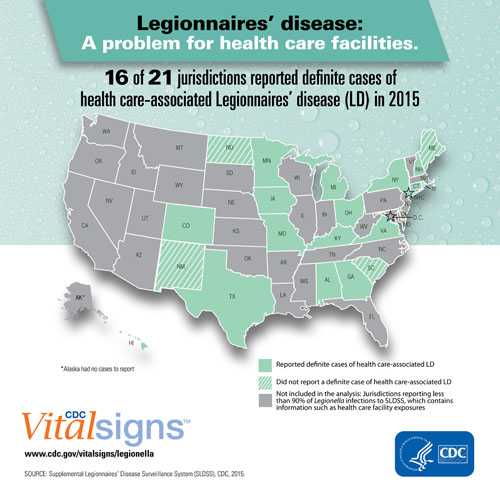Patients in health care facilities at risk for Legionnaires’ disease
Safe water and water management programs can reduce Legionella in health care facilities
Press Release
Embargoed Until: Tuesday, June 6, 2017, 1:00 p.m. ET
Contact: Media Relations
(404) 639-3286

Legionnaires’ disease: A problem for health care facilities. View large image and text description
A new CDC analysis finds that among the 21 U.S. jurisdictions studied, 76 percent reported health care-associated cases of Legionnaires’ disease, a concerning finding since Legionnaires’ disease acquired from health care facilities can be particularly severe. The findings highlight a possibly deadly risk to patients from exposure to Legionella in health care facilities, according to today’s CDC Vital Signs report.
Legionnaires’ disease is a serious lung infection (pneumonia) that people can get by breathing in small droplets of water containing Legionella bacteria. While most cases of Legionnaires’ disease are not associated with health care facilities, 1 in 4 people who get the infection from a health care facility will die. This death rate is higher than for people who get the infection elsewhere.
All 50 states and two large cities report basic data to CDC on Legionnaires’ disease cases, but not all report information on where those people might have been exposed to Legionella, including in health care facilities, hotels, and the community. During 2015, approximately 6,000 cases of Legionnaires’ disease were reported to CDC; only about half included exposure data.
Today’s Vital Signs’ findings are based on exposure data from 20 states and New York City. The analysis was limited to these 21 jurisdictions because they reported exposure information for most of their cases. These details were used to see how often Legionnaires’ disease was associated with health care facilities. Findings indicate that 3 percent of Legionnaires’ disease cases are definitely associated with a health care facility (inpatient stays of 10 days or more before symptoms begin) and an additional 17 percent are possibly associated with a health care facility (exposure to a health care facility for less than 10 days before symptoms begin).
“Legionnaires’ disease in hospitals is widespread, deadly, and preventable. These data are especially important for health care facility leaders, doctors, and facility managers because it reminds them to think about the risks of Legionella in their facility and to take action,” said CDC Acting Director Anne Schuchat, M.D. “Controlling these bacteria in water systems can be challenging, but it is essential to protect patients.”
Among the Legionnaires’ disease cases definitely associated with health care facilities:
- 80 percent were associated with long-term care facilities, 18 percent with hospitals, and 2 percent with both
- Cases were reported from 72 unique facilities, with the number of cases ranging from one to six per facility
- 88 percent were in people 60 years of age or older
“Safe water at a health care facility might not be on a physician’s mind, but it’s an essential element of health care quality,” said Nancy Messonnier, M.D., director of CDC’s National Center for Immunization and Respiratory Diseases. “Having a water management program that focuses on keeping facility water safe can help prevent Legionnaires’ disease.”
A new measure was just put in place on June 2nd to encourage implementation of water management programs. The Centers for Medicare and Medicaid Services released a Survey and Certification Memo stating that health care facilities are expected to develop and adhere to policies and procedures to reduce the risk of Legionella and other waterborne pathogens.
Legionella growth occurs in building water systems that are not managed adequately and where disinfectant levels are low, water is stagnant, or water temperatures are ideal for growth of bacteria. Last year CDC released a toolkit for building owners and managers: Developing a Water Management Program to Reduce Legionella Growth & Spread in Buildings: A Practical Guide to Implementing Industry Standards. Based on ASHRAE Standard 188, a document for building engineers, the toolkit provides a checklist to help identify when a water management program is needed, examples to help identify where Legionella could grow and spread in a building, and ways to reduce the risk of Legionella contamination. The toolkit also includes examples relevant for health care facilities.
Most healthy people do not get Legionnaires’ disease after being exposed to Legionella. People at increased risk of Legionnaire’s disease are 50 years of age or older or have certain risk factors, such as being a current or former smoker, having a chronic disease, or having a weakened immune system.
For more information on today’s Vital Signs, visit www.cdc.gov/VitalSigns. For more information on Legionella, Legionnaires’ disease, and the CDC toolkit, visit www.cdc.gov/legionella.
About Vital Signs
Vital Signs is a monthly report that appears as part of the CDC’s Morbidity and Mortality Weekly Report. Vital Signs provides the latest data and information on key health threats: cancer, obesity, tobacco use, motor vehicle passenger safety, prescription drug overdose, HIV/AIDS, health care-associated infections, cardiovascular health and others.
- Page last reviewed: June 6, 2017
- Page last updated: June 6, 2017
- Content source:



 ShareCompartir
ShareCompartir